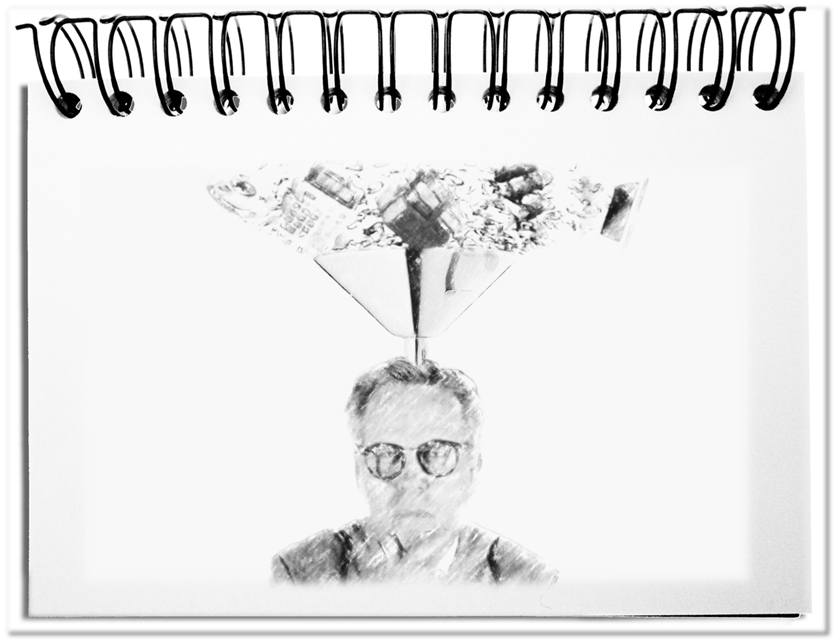Cultural artifacts have now become economic products and services that follow the rules of the market – literature, music as well as the performing and visual arts. Artists thus become designers of new offers. A wide variety of channels have to be continuously supplied with content – television and radio stations, concert stages, theatres and museums. A quick way to expand your own palette is the fanciless reuse of existing offers. In the absence of subject matters, interesting outgrowths occur. Television stations live from reruns; cinema blockbusters become serials and remakes; pop music lives from cover songs and cover bands; theater plays are completely alienated under well-known titles. Do the artists lack ideas or is the market forcing them to reuse work without imagination?
Previously, the rule was: form follows function. Creatives came up with content and put it into a form. Do the markets demand the endless continuation of the form and fill it always with the same content? Are there rarely enough contents? The following elements are reused thereby.
- The plot
The red thread that runs through a story follows a certain rhythm that ensures that the attention of the audience is continuously refreshed once in a short while. The associated actions follow a conceivable sequence that is interspersed with suspense – in a thriller, the perpetrator is uncovered at the end, during the course or at the beginning of the story; through deliberately interspersed effects such as unknown cultures, unusual role models or elements from other genres (e.g. esotericism in an adventure). Depending on the culture the actual action is always the same – in the USA the investigation team and in Germany the commissioner with his assistant.
Retro provides target groups fanciless repeated plots. - The format
Depending on the target media, e,g, print, radio, film or Internet, the plots are differently offered. A new novel is planned like the rollout of a product – after publication, the book is discussed on the radio and the television, and reviews are launched in the relevant magazines and eventually sold to the highest bidder for further exploitation. What counts is the signal effect of the original title. Good examples of this kind of marketing are Perfume by Patrick Süskind or The Little Prince by Antoine St. Exupéry, which have already completed their rounds in various formats. The actual story doesn’t change – just the format.
Retro often provides the target group fanciless repeated formats. - The theme
The Zeitgeist brings different subjects to the fore, which, if successful, will be repeated by many – the psyche at the beginning of the twentieth century, totalitarianism after the Second World War or the GDR after German reunification. Today, scientific findings in psychology are used in television series such as Lie to me or Leverage to attract viewers with insights into non-verbal communication. The attraction lies in new insights that could be used in everyday life.
Retro often provides the target group fanciless repeated topics. - The protagonists
The introduced actors are the supporting pillars of a work – e.g. religious characters in the visual arts; mythology in music; contemporary people in stories. Honoré de Balzac with his human comedy showed the French society of the 19th century. Jules Verne had his courageous researchers who broke the boundaries of the world. Gabriel Garcia Marquez wrapped the South American reality in magic. Heinrich Boell provided a picture of the FRG during the economic upswing. Today’s protagonists are the same again and again: the crazy scientist; the spiritualized commissioner; the punk investigator. Seldom new personalities emerge, as in the book The reader by Bernhard Schlink.
Retro often provides the target group fanciless repeated protagonists. - The Songs
With the spread of records, the twentieth century became the age of popularized music. Whereas in the past music required musicians, music can be reproduced and enjoyed at any time of the day or night through the canning of records and today’s Internet. In addition, the countless radio broadcasts and films require a continuous flow of new compositions. Certain styles are reused. The fate of the new musicians is to sound like Led Zeppelin or Adele. And at the same time old pieces are re-staged as covers, at best interpreted in a new way. It is possible that music has reached its limits and new harmonies are no longer possible without repeating existing melodies.
Retro often provides the target group fanciless repeated compositions. - The design
Designed packaging is in the economy an important element of marketing. The customers accept an offer, if the packaging appeals to them – the performing arts use for this purpose a special stage; the visual arts the spectacular exhibition space; music and books the book cover. Part of the design is the attractive title that triggers the first buying impulse – The secret; What everyone needs to know; Passive income for everybody. The advertising poster, the flap text and the trailer are further components of the packaging that suggest certain quality criteria with their design and sometimes promise more than they can keep. The actual content takes a back seat – the design determines the business.
Retro often provides the target group fanciless repeated designs.
Bottom line: The countless remakes in cinema and TV, the endless repetitions of quiz formats, the new cover bands and the adoption of classical themes in computer games enable the industrial exploitation of cultural brands. The fanciless reuse of old plots, formats, themes, protagonists, pieces of music and designs flood the sales areas with a look backwards. The approach of packing old things into new vessels and selling them shifts creativity from content to form and prevents that way that new things appear. Therefore retro stands for fanciless reuse.


